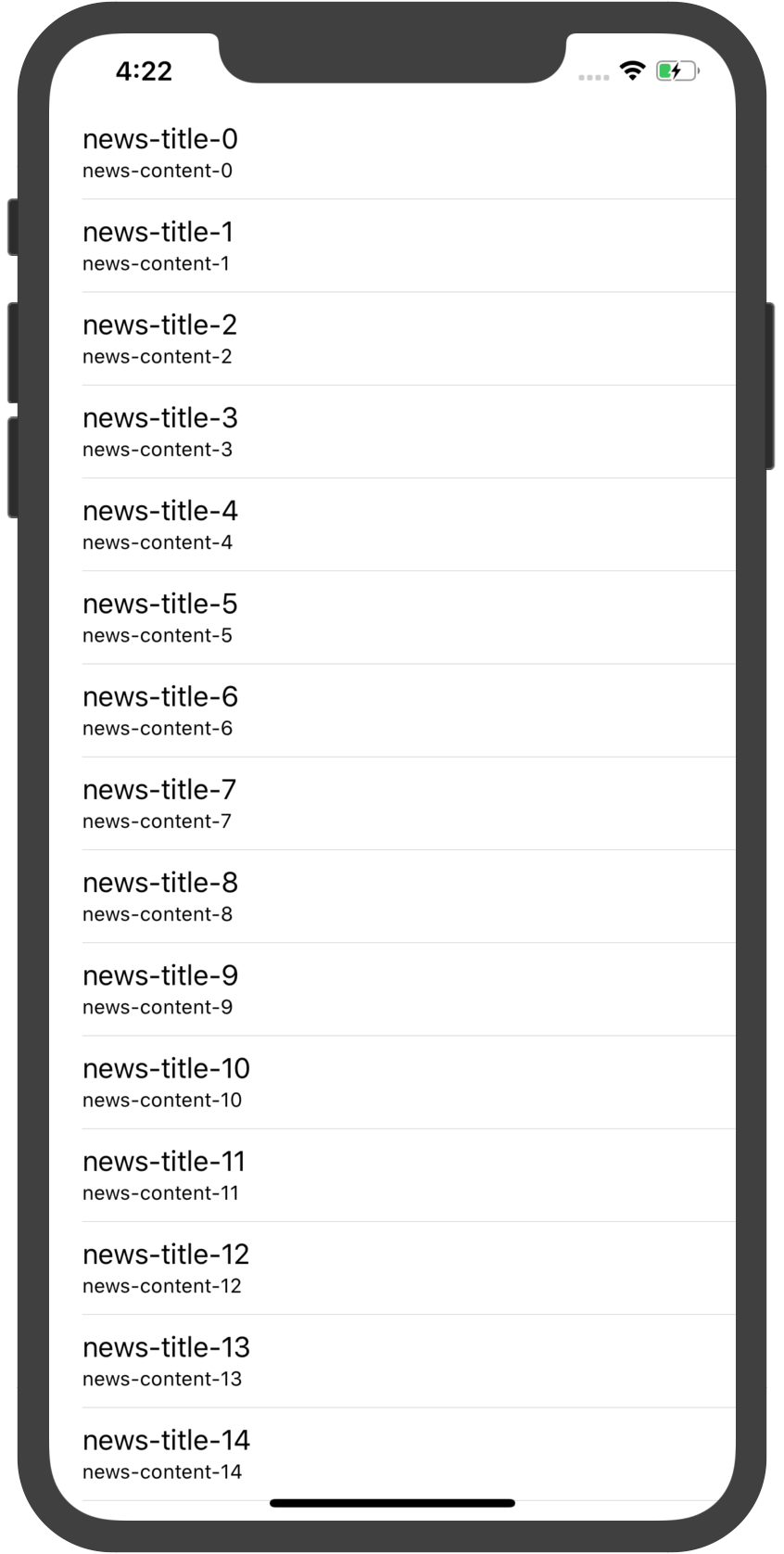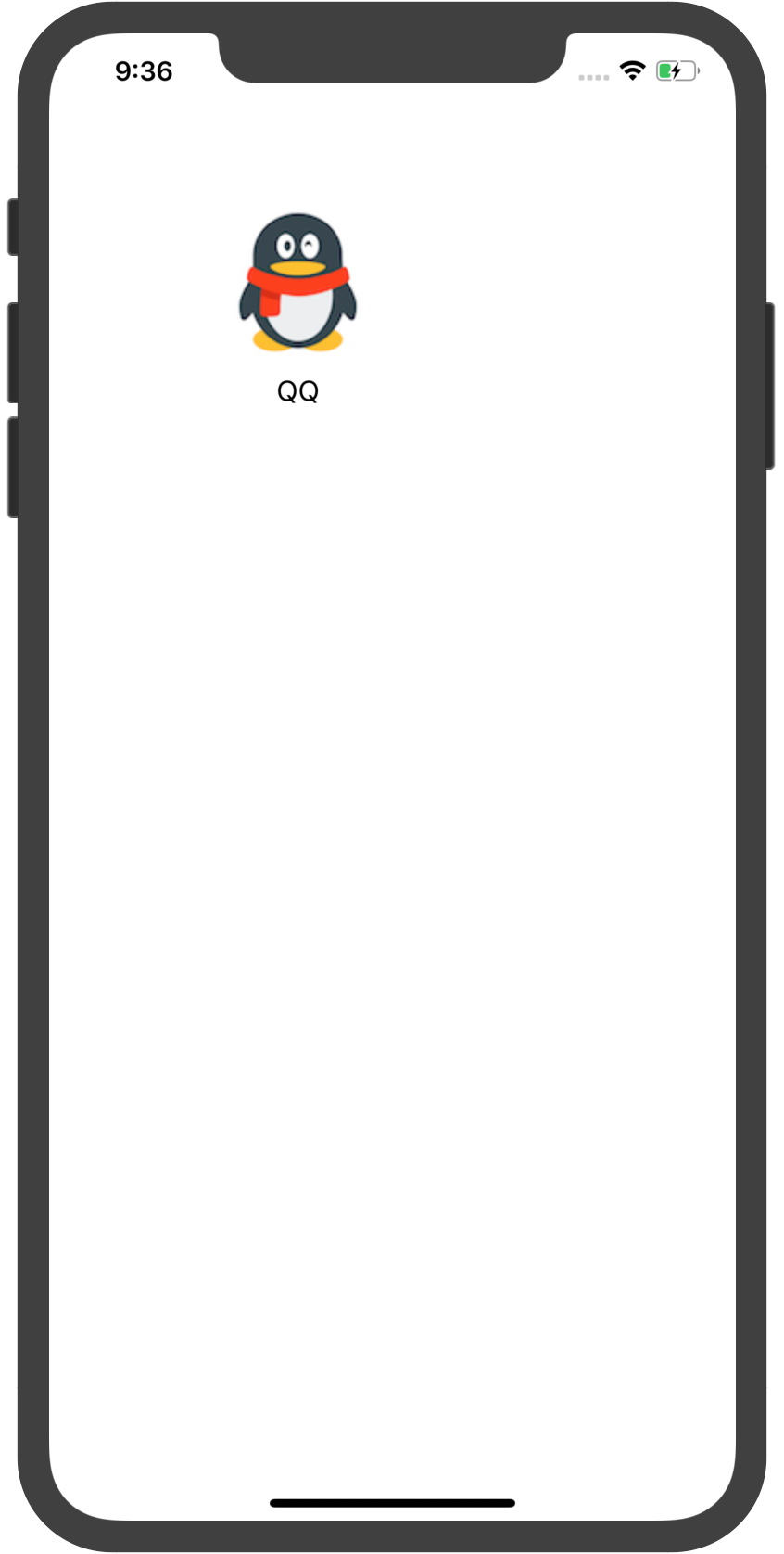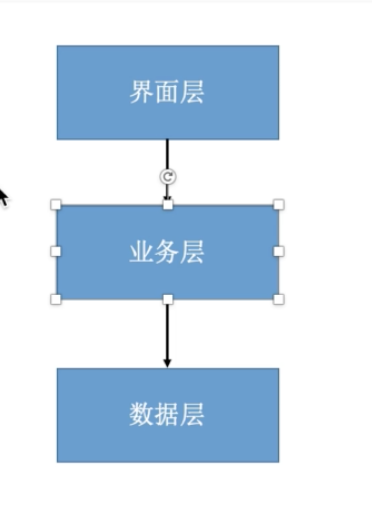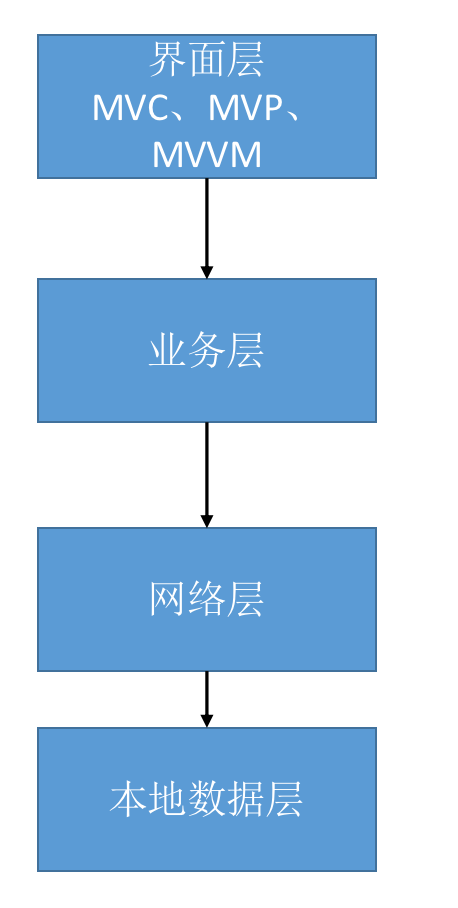何为架构?
架构指的是开发中的设计方案。类与类之间的关系,模块与模块之间的关系,客户端与服务器的关系等等都可称之为架构的一部分。
我们在iOS开发过程中经常听到的架构有:
MVC、MVP、MVVP、VIPER、CDD
也有另外一种架构的说法:
三层架构、四层架构
一、MVC的理解
苹果官方给出的关于MVC的理解是:Model-View-Controller


MVC通讯规则:
1、Controller ->Model:单向通信,Controller需要将Model呈现给用户,因此需要知道模型的一切,还需要有同Model完全通信的能力,并且能任意使用Model的API。
2、Controller ->View:单向通信,Ccontroller通过View来布局用户界面。
3、Model ->View:永远不要直接通信,Model是独立于UI的,并不需要和View直接通信,View通过Controller获取Model数据。
看如下代码:
创建一个名为News的模型
News.h
#import <Foundation/Foundation.h> @interface News : NSObject @property (copy, nonatomic) NSString *title; @property (copy, nonatomic) NSString *content; @end
News.m
#import "News.h" @implementation News @end
NewsViewController.h
#import <UIKit/UIKit.h> @interface NewsViewController : UITableViewController @end
NewsViewController.m
#import "NewsViewController.h"
#import "News.h"
@interface NewsViewController ()
@property (strong, nonatomic) NSMutableArray *newsData;
@property (strong, nonatomic) NSMutableArray *shopData;
@end
@implementation NewsViewController
- (void)viewDidLoad {
[super viewDidLoad];
[self loadNewsData];
}
//模拟加载model数据,在实际开发中应该是通过网络加载或者获取缓存中的模型数据
- (void)loadNewsData
{
self.newsData = [NSMutableArray array];
for (int i = 0; i < 20; i++) {
News *news = [[News alloc] init];
news.title = [NSString stringWithFormat:@"news-title-%d", i];
news.content = [NSString stringWithFormat:@"news-content-%d", i];
[self.newsData addObject:news];
}
}
#pragma mark - Table view data source
- (NSInteger)tableView:(UITableView *)tableView numberOfRowsInSection:(NSInteger)section {
return self.newsData.count;
}
- (UITableViewCell *)tableView:(UITableView *)tableView cellForRowAtIndexPath:(NSIndexPath *)indexPath {
UITableViewCell *cell = [tableView dequeueReusableCellWithIdentifier:@"NewsCell" forIndexPath:indexPath];
News *news = self.newsData[indexPath.row];
cell.detailTextLabel.text = news.price;
cell.textLabel.text = shop.name;
return cell;
}
@end

通过上述代码和运行结果可以看到,Model是News,Controller是NewViewController ,View是tableView(包含在Controller中,这是一个tableViewController)。
现在MVC三元素已经有了,细看一下它的具体实现。
1、controller确实是拥有了News这个model,并在controller中创建加载这个模型的数据。
2、controller也拥有了view,这个view就是内置的tableView。
3、view中并没有拥有News这个model,这两者并没有直接通讯,两者并不知道彼此的存在。
4、view之所以显示模型数据,是因为Controller把model里面的每一个属性都拿出来赋值到view中的。
MVC模型的优点:
1、因为Model和View没有直接联系,互相不知道对方的存在,所以低耦合性,有利于开发分工,有利于组件重用,可维护性高。
缺点:
1、Controller的代码过于臃肿,因为它需要连接Model和View的通讯。
二、MVC的变种
看如下代码:
创建一个名为APP的model
App.h
#import <Foundation/Foundation.h> @interface App : NSObject @property (copy, nonatomic) NSString *name; @property (copy, nonatomic) NSString *image; @end
App.m
#import "App.h" @implementation App @end
创建一个APPView.h
#import <UIKit/UIKit.h> @class App, AppView; @protocol AppViewDelegate <NSObject> @optional - (void)appViewDidClick:(AppView *)appView; @end @interface AppView : UIView @property (strong, nonatomic) App *app; @property (weak, nonatomic) id<AppViewDelegate> delegate; @end
APPView.m
#import "AppView.h"
#import "App.h"
@interface AppView()
@property (weak, nonatomic) UIImageView *iconView;
@property (weak, nonatomic) UILabel *nameLabel;
@end
@implementation AppView
- (instancetype)initWithFrame:(CGRect)frame
{
if (self = [super initWithFrame:frame]) {
UIImageView *iconView = [[UIImageView alloc] init];
iconView.frame = CGRectMake(0, 0, 100, 100);
[self addSubview:iconView];
_iconView = iconView;
UILabel *nameLabel = [[UILabel alloc] init];
nameLabel.frame = CGRectMake(0, 100, 100, 30);
nameLabel.textAlignment = NSTextAlignmentCenter;
[self addSubview:nameLabel];
_nameLabel = nameLabel;
}
return self;
}
- (void)setApp:(App *)app
{
_app = app;
self.iconView.image = [UIImage imageNamed:app.image];
self.nameLabel.text = app.name;
}
- (void)touchesBegan:(NSSet<UITouch *> *)touches withEvent:(UIEvent *)event
{
if ([self.delegate respondsToSelector:@selector(appViewDidClick:)]) {
[self.delegate appViewDidClick:self];
}
}
@end
ViewController.m
#import "ViewController.h"
#import "App.h"
#import "AppView.h"
@interface ViewController () <AppViewDelegate>
@end
@implementation ViewController
- (void)viewDidLoad {
[super viewDidLoad];
// 创建view
AppView *appView = [[AppView alloc] init];
appView.frame = CGRectMake(100, 100, 100, 150);
appView.delegate = self;
[self.view addSubview:appView];
// 加载模型数据
App *app = [[App alloc] init];
app.name = @"QQ";
app.image = @"QQ";
// 设置数据到view上
appView.app = app;
}
#pragma mark - AppViewDelegate
- (void)appViewDidClick:(AppView *)appView
{
NSLog(@"控制器监听到了appView的点击");
}
@end

通过上述代码可以看出:
1、model作为一个对象被添加到view中,model中的数据在创建model的时候被使用。
2、view中的控件被隐藏,外界不知道view内部的结构。
3、对controller进行了瘦身,在controller中只需要传入model对象给view即可。
优点:对Controller进行瘦身,将view内部的细节封装起来,外界不知道view内部的具体实现。
缺点:view依赖于model。
三、MVP
Model-View-Presenter(主持者):跟MVC模型类似,只不过是用Presenter代替了Controller来对model和view进行调度。
看如下代码:
APP和APPView代码跟上面代码一致,我们此时需要增加一个AppPresenter文件
AppPresenter.h
#import <UIKit/UIKit.h> @interface AppPresenter : NSObject - (instancetype)initWithController:(UIViewController *)controller; @end
AppPresenter.m
#import "AppPresenter.h"
#import "App.h"
#import "AppView.h"
@interface AppPresenter() <AppViewDelegate>
@property (weak, nonatomic) UIViewController *controller;
@end
@implementation AppPresenter
- (instancetype)initWithController:(UIViewController *)controller
{
if (self = [super init]) {
self.controller = controller;
// 创建View
AppView *appView = [[AppView alloc] init];
appView.frame = CGRectMake(100, 100, 100, 150);
appView.delegate = self;
[controller.view addSubview:appView];
// 加载模型数据
App *app = [[App alloc] init];
app.name = @"QQ";
app.image = @"QQ";
// 赋值数据
[appView setName:app.name andImage:app.image];
}
return self;
}
#pragma mark - AppViewDelegate
- (void)appViewDidClick:(AppView *)appView
{
NSLog(@"presenter 监听了 appView 的点击");
}
@end
ViewController.m
#import "ViewController.h"
#import "AppPresenter.h"
@interface ViewController ()
@property (strong, nonatomic) AppPresenter *presenter;
@end
@implementation ViewController
- (void)viewDidLoad {
[super viewDidLoad];
self.presenter = [[AppPresenter alloc] initWithController:self];
}
@end
通过上述代码可以看出:
1.通过一个Presenter的中间媒介把原来在controller中的逻辑放在自己的实现方法里。
2.如果controller中需要不同的模块,可以创建多个Presenter来实现。比如想在controller中增加两个view,可以创建两个Presenter实现这两个view的实现。
四、MVVM
概念:MVVM是model-view-viewModel的缩写,它是一种基于前端开发的架构模式,核心是提供对view和ViewModel的双向数据绑定,这使得ViewModel的状态改变可以自动传递给View,即所谓的数据双向绑定。在H5还未流行的时候MVC作为web的最佳实践是OK的,因为Web应用的View相对来说比较简单,前端所需的数据在后端基本上都可以处理好,View层主要是做展示,用Controller来处理复杂的业务逻辑。所以View层相对来说比较轻量,就是所谓的瘦客户端思想。
看如下代码:
News.h
#import <Foundation/Foundation.h> @interface News : NSObject @property (copy, nonatomic) NSString *title; @property (copy, nonatomic) NSString *content; @end
News.m
@implementation News @end
NewsViewModel.h
#import <Foundation/Foundation.h> @interface NewsViewModel : NSObject -(void)loadNewsData:(void (^)(NSArray *newsDdata))completion; @end
NewsViewModel.m
#import "NewsViewModel.h"
#import "News.h"
@implementation NewsViewModel
//通常在此处发送网络请求获取数据,实现数据转字典模型等操作
-(void)loadNewsData:(void (^)(NSArray *))completion
{
if (!completion) return;
NSMutableArray *newsData = [NSMutableArray array];
for (int i = 0; i < 20; i++) {
News *news = [[News alloc] init];
news.title = [NSString stringWithFormat:@"news-title-%d", i];
news.content = [NSString stringWithFormat:@"news-content-%d", i];
[newsData addObject:news];
}
completion(newsData);
}
@end
NewsViewController.m
#import "NewsViewController.h"
#import "News.h"
#import "NewsViewModel.h"
@interface NewsViewController ()
@property (strong, nonatomic) NSMutableArray *newsData;
@property (strong, nonatomic) NewsViewModel *newsVM;
@end
@implementation NewsViewController
- (void)viewDidLoad {
[super viewDidLoad];
self.newsVM = [[NewsViewModel alloc] init];
[self.newsVM loadNewsData:^(NSArray *newsDdata) {
self.newsData = newsDdata;
}];
}
#pragma mark - Table view data source
- (NSInteger)tableView:(UITableView *)tableView numberOfRowsInSection:(NSInteger)section {
return self.newsData.count;
}
- (UITableViewCell *)tableView:(UITableView *)tableView cellForRowAtIndexPath:(NSIndexPath *)indexPath {
UITableViewCell *cell = [tableView dequeueReusableCellWithIdentifier:@"NewsCell" forIndexPath:indexPath];
MJNews *news = self.newsData[indexPath.row];
cell.detailTextLabel.text = news.content;
cell.textLabel.text = news.title;
return cell;
}
通过上诉代码可以知道:
1、viewModel中发送网络请求、实现字典转模型操作。
2、在Controller中获取viewModel的值,然后将数据传递给view显示。
五、MVVM变种
基于上面MVC变种,我们可以仿照它实现MVVM的变种。
看如下代码:
App.h
import <Foundation/Foundation.h> @interface App : NSObject @property (copy, nonatomic) NSString *name; @property (copy, nonatomic) NSString *image; @end
App.m
#import "App.h" @implementation App @end
AppView.h
#import <UIKit/UIKit.h> @class AppView, AppViewModel; @protocol AppViewDelegate <NSObject> @optional - (void)appViewDidClick:(AppView *)appView; @end @interface AppView : UIView @property (weak, nonatomic) AppViewModel *viewModel; @property (weak, nonatomic) id<AppViewDelegate> delegate; @end
AppView.m
#import "AppView.h"
#import "NSObject+FBKVOController.h"
@interface AppView()
@property (weak, nonatomic) UIImageView *iconView;
@property (weak, nonatomic) UILabel *nameLabel;
@end
@implementation AppView
- (instancetype)initWithFrame:(CGRect)frame
{
if (self = [super initWithFrame:frame]) {
UIImageView *iconView = [[UIImageView alloc] init];
iconView.frame = CGRectMake(0, 0, 100, 100);
[self addSubview:iconView];
_iconView = iconView;
UILabel *nameLabel = [[UILabel alloc] init];
nameLabel.frame = CGRectMake(0, 100, 100, 30);
nameLabel.textAlignment = NSTextAlignmentCenter;
[self addSubview:nameLabel];
_nameLabel = nameLabel;
}
return self;
}
- (void)setViewModel:(AppViewModel *)viewModel
{
_viewModel = viewModel;
__weak typeof(self) waekSelf = self;
[self.KVOController observe:viewModel keyPath:@"name" options:NSKeyValueObservingOptionNew block:^(id _Nullable observer, id _Nonnull object, NSDictionary<NSKeyValueChangeKey,id> * _Nonnull change) {
waekSelf.nameLabel.text = change[NSKeyValueChangeNewKey];
}];
[self.KVOController observe:viewModel keyPath:@"image" options:NSKeyValueObservingOptionNew block:^(id _Nullable observer, id _Nonnull object, NSDictionary<NSKeyValueChangeKey,id> * _Nonnull change) {
waekSelf.iconView.image = [UIImage imageNamed:change[NSKeyValueChangeNewKey]];
}];
}
- (void)touchesBegan:(NSSet<UITouch *> *)touches withEvent:(UIEvent *)event
{
if ([self.delegate respondsToSelector:@selector(appViewDidClick:)]) {
[self.delegate appViewDidClick:self];
}
}
@end
AppViewModel.h
#import <UIKit/UIKit.h> @interface AppViewModel : NSObject - (instancetype)initWithController:(UIViewController *)controller; @end
AppViewModel.m
#import "AppViewModel.h"
#import "App.h"
#import "AppView.h"
@interface AppViewModel() <AppViewDelegate>
@property (weak, nonatomic) UIViewController *controller;
@property (copy, nonatomic) NSString *name;
@property (copy, nonatomic) NSString *image;
@end
@implementation AppViewModel
- (instancetype)initWithController:(UIViewController *)controller
{
if (self = [super init]) {
self.controller = controller;
// 创建View
AppView *appView = [[AppView alloc] init];
appView.frame = CGRectMake(100, 100, 100, 150);
appView.delegate = self;
appView.viewModel = self;
[controller.view addSubview:appView];
// 加载模型数据
App *app = [[App alloc] init];
app.name = @"QQ";
app.image = @"QQ";
// 设置数据
self.name = app.name;
self.image = app.image;
}
return self;
}
#pragma mark - AppViewDelegate
- (void)appViewDidClick:(AppView *)appView
{
NSLog(@"viewModel 监听了 appView 的点击");
}
@end
ViewController.m
#import "ViewController.h"
#import "AppViewModel.h"
@interface ViewController ()
@property (strong, nonatomic) AppViewModel *viewModel;
@end
@implementation ViewController
- (void)viewDidLoad {
[super viewDidLoad];
self.viewModel = [[AppViewModel alloc] initWithController:self];
}
@end
通过上述代码可以得知:
1、把view放到viewModel中而不是controller中。这样让controller持有viewModel即可。
2、在viewmodel中对数据进行处理,如发送网络请求、字典转模型。把得到的数据传递到view中。
六、MVC和MVVM的区别:
最大的区别是:实现了View和Model的自动更新,也就是说当model的属性发生改变时,我们不再手动的操作,通过viewModel来处理数据的业务逻辑,这种低耦合模式提高代码的可重用性。
总的来说MVVM比MVC精简很多,一定程度上简化了界面与业务的依赖性,也解决了数据的频繁更新问题。对于这两种模式,可能比较复杂的情况下分不清Model和View,但是在实际开发中大可不必纠结。只要掌握了架构的思想,针对不同的业务情况,选择最适合的架构来解决问题即可。
七、三层架构和四层架构

业务层:就是一些点击事件。
数据层:负责数据库或者网络请求获取的数据。
比如实现一个新闻列表的功能。新闻列表界面(即tableView)就是界面层,加载新闻数这一功能就是业务层,而数据的来源则是数据层。

与三层架构不同的是多了一个网络层,这样更加精细的分工可以把网络请求和数据层实现分离。